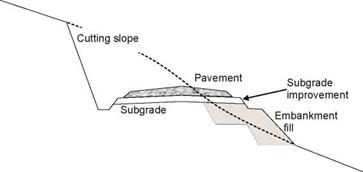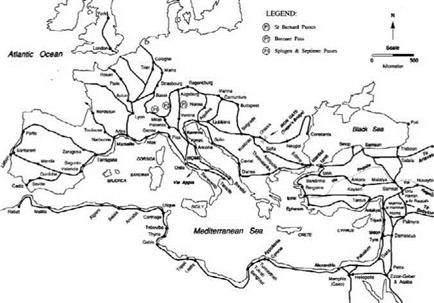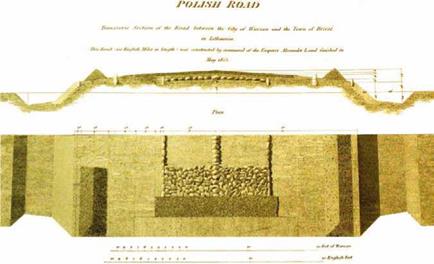It is conventional to classify pavements according to their construction – flexible (i. e. principally made of asphalt or only granular), rigid (i. e. concrete) and semi-rigid (i. e. made of both concrete and asphalt layers). From the point of view of water movements these classifications are not very relevant. Instead, pavements may be classified by the way in which water enters and moves in the pavement. On this basis the following classification is more appropriate:
A. Impermeable throughout the construction
B. Impermeable surface and structural layers
C. Permeable surface over impermeable structural layers
D. Permeable throughout with water storage capacity within the structure
E. Permeable throughout without water storage capacity
F. Cracked or jointed surface layers over permeable lower layers
Each type of pavement can be constructed on pervious or impervious ground and the ground – (or surface-) water level could be below or above the bottom of the construction. Thus each of the above 6 classes could, in principle, be sub-divided according to these conditions. In fact, except in limited circumstances, only a few of the classes and their sub-divisions have meaning in situations that are at all frequent. Thus circumstances in which the surrounding water is above the base of the construction are rare. Normally drainage (e. g. in the form of lateral drains) is provided to avoid this possibility.
Class A constructions are relatively rare. Full-depth asphaltic construction has been used in a few situations, most often in city streets, but its adoption has not been widespread. In this case significant water flows to the subgrade through the pavement layers are not expected but if water does become trapped at the subgrade surface (e. g. where the subgrade is impermeable), then it may be difficult to get it out of the pavement.
Class B pavements are probably the most common in developed countries, typically comprising asphalt or Portland concrete over a granular base or sub-base. The granular layers can act as drainage layers if they are permeable enough and have appropriate falls and outlets.
Class C constructions have become relatively common in recent years. The most common form of these is a flexible asphalt pavement with a porous asphalt surfacing. Rain water infiltrates the surface and then runs sub-horizontally within the asphalt to a drain that must be provided (some more details are included in Chapter 5).
Class D pavements seem, at first an undesirable concept. Storing water in the pavement will be likely to reduce the structural capacity of the construction. However, the chief motivation for this is to reduce runoff rates to surface water bodies (streams, rivers, lakes). With increasing urbanisation and areas of “hard” surfaces, rainfall arrives more rapidly at receiving watercourses than it does in “green” environments where vegetation and partial sorption into soil delay the arrival. The consequence is that river hydrographs become more “peaky” and flooding more common. Therefore, the provision of water storage within the pavement reverses this trend, delaying arrival of rain to the watercourse. Furthermore, the slowing of water as it percolates through the storage area means that it drops particulates. Also, some sorption of contaminants from the percolating water is achieved. Thus, the water arriving at the water body is also cleaner than it would otherwise have been. They are discussed a little more in Chapter 13.
Class E pavements are usually those with no sealed surface. They are common in parts of Scandinavia and form the minor road networks in many countries. Although unsealed, a well compacted surface of material with sufficient fine particles to block the pores and without potholes and ruts can shed a large proportion of the rain that falls on it. Conversely, distressed pavements of this type rather easily take in water and then tend to rapidly deteriorate further.
In countries with a network of jointed concrete pavements – Class F pavements – entry of water through joints can be significant, especially as the pavement ages and the joint fill compounds become less effective at keeping the water out. Asphaltic pavements that have suffered significant cracking could also be placed in Class F.
Where water does enter the pavement through the upper layers (Classes D, E and F) then the type of subgrade is likely to have more significance than in other pavements. Impermeable subgrades will necessitate horizontal or sub-horizontal egress. Permeable subgrades will allow vertical drainage towards the water table. Impermeable pavement subgrades are typically comprised of clay. When water reaches these it can cause softening and deterioration of the mechanical behaviour of the pavement (see Fig. 1.6).
Porous pavements that are designed to beneficially carry water through their layers (Classes C and D) are liable to deteriorate in their ability to do so, with time, as solid particles block the pore spaces. Porous surfacings are prone to ravelling as direct trafficking and the induced water pressure pulses in the pores and microcracks between particles tends to cause particles to separate one from another. This process, known as “stripping”, is common to all asphaltic mixtures to some degree, but is more prevalent in porous asphalts where, of necessity, particles are less firmly fixed together than is conventional in densely-graded materials (see Chapter 5).







 Thin asphaltic ‘chip-seal’ (<30mm) Asphaltic or concrete Unbound aggregate layer(s) surfacing & base layers
Thin asphaltic ‘chip-seal’ (<30mm) Asphaltic or concrete Unbound aggregate layer(s) surfacing & base layers Fig. 1.6 Malfunction of the lower pavement layers. A depression in an impermeable sub-grade allows water in the aggregate layer to collect there, leading to subgrade softening and consequent rutting of the whole pavement
Fig. 1.6 Malfunction of the lower pavement layers. A depression in an impermeable sub-grade allows water in the aggregate layer to collect there, leading to subgrade softening and consequent rutting of the whole pavement


